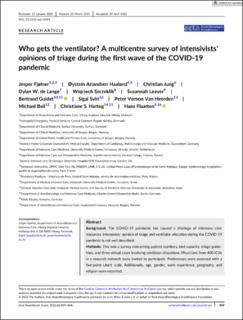| dc.contributor.author | Fjølner, Jesper | |
| dc.contributor.author | Haaland, Øystein Ariansen | |
| dc.contributor.author | Jung, Christian | |
| dc.contributor.author | de Lange, Dylan W. | |
| dc.contributor.author | Szczeklik, Wojciech | |
| dc.contributor.author | Leaver, Susannah | |
| dc.contributor.author | Guidet, Bertrand | |
| dc.contributor.author | Sviri, Sigal | |
| dc.contributor.author | Van Heerden, Peter Vernon | |
| dc.contributor.author | Beil, Michael | |
| dc.contributor.author | Hartog, Christiane S. | |
| dc.contributor.author | Flaatten, Hans Kristian | |
| dc.date.accessioned | 2022-09-14T12:13:09Z | |
| dc.date.available | 2022-09-14T12:13:09Z | |
| dc.date.created | 2022-09-12T16:00:29Z | |
| dc.date.issued | 2022 | |
| dc.identifier.issn | 0001-5172 | |
| dc.identifier.uri | https://hdl.handle.net/11250/3017830 | |
| dc.description.abstract | Background
The COVID-19 pandemic has caused a shortage of intensive care resources. Intensivists' opinion of triage and ventilator allocation during the COVID-19 pandemic is not well described.
Methods
This was a survey concerning patient numbers, bed capacity, triage guidelines, and three virtual cases involving ventilator allocations. Physicians from 400 ICUs in a research network were invited to participate. Preferences were assessed with a five-point Likert scale. Additionally, age, gender, work experience, geography, and religion were recorded.
Results
Of 437 responders 31% were female. The mean age was 44.4 (SD 11.1) with a mean ICU experience of 13.7 (SD 10.5) years. Respondents were mostly European (88%). Sixty-six percent had triage guidelines available. Younger patients and caretakers of children were favoured for ventilator allocation although this was less clear if this involved withdrawal of the ventilator from another patient. Decisions did not differ with ICU experience, gender, religion, or guideline availability. Consultation of colleagues or an ethical committee decreased with age and male gender.
Conclusion
Intensivists appeared to prioritise younger patients for ventilator allocation. The tendency to consult colleagues about triage decreased with age and male gender. Many found such tasks to be not purely medical and that authorities should assume responsibility for triage during resource scarcity. | en_US |
| dc.language.iso | eng | en_US |
| dc.publisher | Wiley | en_US |
| dc.rights | Attribution-NonCommercial-NoDerivatives 4.0 Internasjonal | * |
| dc.rights.uri | http://creativecommons.org/licenses/by-nc-nd/4.0/deed.no | * |
| dc.title | Who gets the ventilator? A multicentre survey of intensivists' opinions of triage during the first wave of the COVID-19 pandemic | en_US |
| dc.type | Journal article | en_US |
| dc.type | Peer reviewed | en_US |
| dc.description.version | publishedVersion | en_US |
| dc.rights.holder | Copyright 2022 The Authors | en_US |
| cristin.ispublished | true | |
| cristin.fulltext | original | |
| cristin.qualitycode | 1 | |
| dc.identifier.doi | 10.1111/aas.14094 | |
| dc.identifier.cristin | 2050937 | |
| dc.source.journal | Acta Anaesthesiologica Scandinavica | en_US |
| dc.source.pagenumber | 859-868 | en_US |
| dc.identifier.citation | Acta Anaesthesiologica Scandinavica. 2022, 66 (7), 859-868. | en_US |
| dc.source.volume | 66 | en_US |
| dc.source.issue | 7 | en_US |

